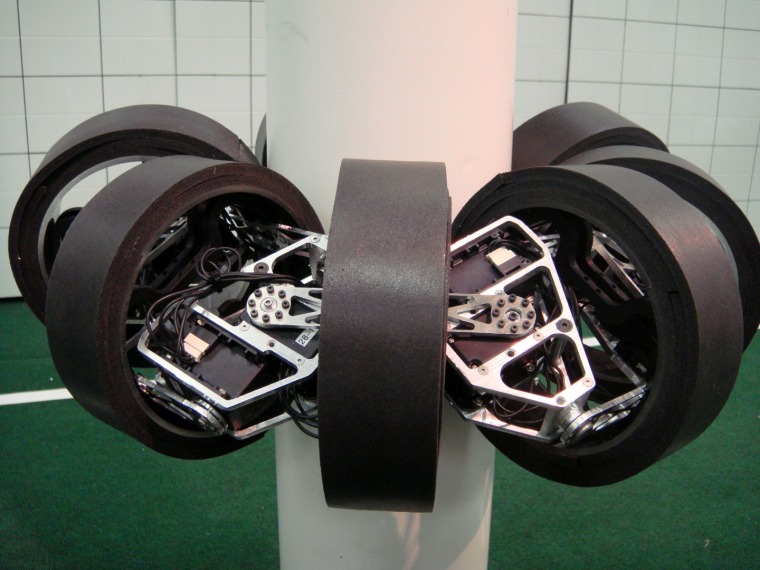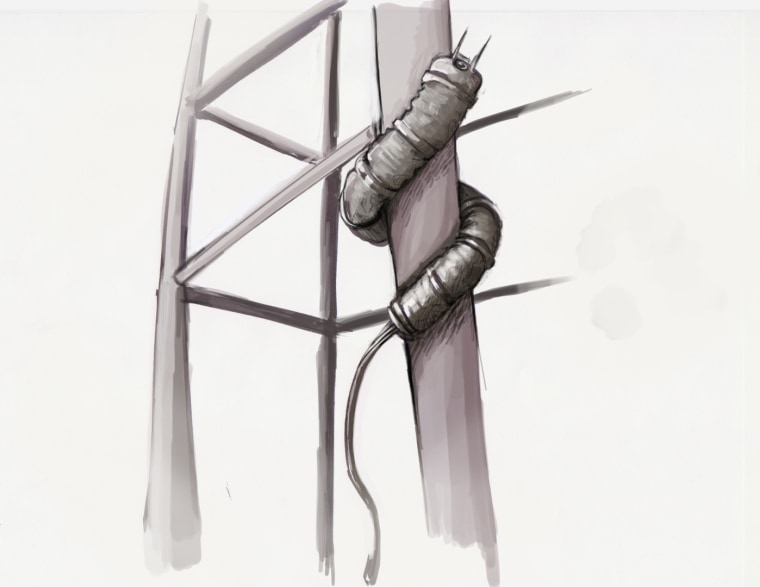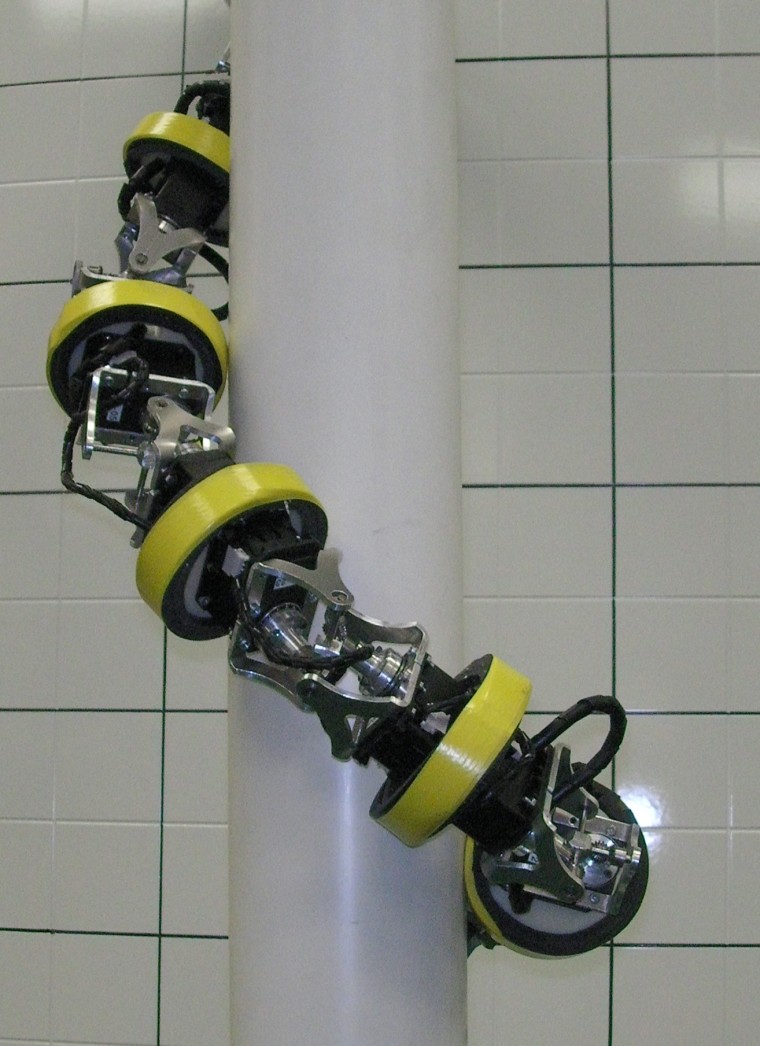Snake-like robots that can climb scaffolding to inspect high-rise construction sites, bend at will to defuse roadside bombs or roll down your esophagus to peer at your digestive tract may soon be lending construction workers, soldiers and doctors a flexible hand.
Among the growing menagerie of crawling, scuttling, swimming and slithering robots, researchers have developed a collection of articulated snakebots that reach beyond the usual repertoire of biological motion by literally rolling up or down obstacles.
Dennis Hong, director of the Robotics & Mechanisms Laboratory (RoMeLa) at Virginia Tech in Blacksburg, Va., said most snake-inspired robots have been engineered for sidewinding or other ground-based locomotion. Likewise, his lab’s HyDRAS-Ascent prototype (or Hyper-redundant Discrete Robotic Articulated Serpentine) can unfold and move around on the ground.
But the big idea behind the 3-foot-long snakebot, which came to Hong in a middle-of-the-night inspiration, was to use flexible universal joints to let the mechanical snake roll up poles, scaffolds and other structures.
“The quick big picture application is reducing human injuries — and ultimately death— at construction sites,” said Gabriel Goldman, a graduate student in Hong’s lab who has worked extensively on the award-winning project.
Goldman cited recent U.S. Bureau of Labor Statistics reports, which suggest that falls remain a major source of workplace fatalities. They accounted for 355 of the 877 reported deaths among construction workers in the bureau’s preliminary report for 2007, for example.
For the past decade, falls have been second only to highway incidents in the number of reported work-related deaths.
Snakebots equipped with built-in cameras and sensors could take the place of workers in performing dangerous tasks like visual inspections of high-rises or bridge piers.
“The pole doesn’t have to be circular,” Goldman said. “Imagine you have a rectangular or square support — as long as there’s sufficient area to contact, it could be used on other workplace structures.”
But how does the snake hold on?

“Imagine you’re holding a Coke can,” he said. “Similarly, the snake would be holding that pole using its grasping force.” The HyDRAS-Ascent and its more powerful successor, the HyDRAS-Ascent II, can wrap around a pole in either a helical or doughnut-like shape.
The climbing movement, he said, is akin to that of rotational joints in the human body. Your fingers, for example, have single rotational joints that allow each digit to bend forward. The snake robots have a universal joint structure, in which two rotational joints intersect like a plus sign. The result is a capacity for much broader movement, like the rotation of your wrists.
Within each HyDRAS robot, small electric motors generate an oscillating motion at the universal joints between each module, leading to a sort of wobble along the entire length.
“The cool thing is that you can coordinate that in a particular way,” Hong said, “and the entire snake actually generates a rolling motion, twisting about its own axis, so that it actually rolls up the pole — but it’s not on wheels.”
The unusual motion offers other advantages.
“Let’s say you’re rolling up a pole and you come to a T-junction or an X-junction,” Hong said. The robot could unwrap its head and use a camera to look around, letting the controller choose where to direct it next. “Even if the pole diameter changes, or if it changes from circular to rectangular, you can get the snake to move over obstacles or take a branch if it’s a tree-like structure,” he said.
A related robot called CIRCA (or Climbing Inspection Robot with Compressed Air), relies on artificial muscles that could tap a construction site’s compressed air stores to contract and expand. “When you put pressure into them, they contract like your arm does. It’s like you’re taking your arm and putting your bicep up,” Goldman said. That contraction generates the wobbling motion that collectively creates the roll.
Snakebots unleashed
Currently, the robots are tethered to a laptop computer. But the lab is moving toward more autonomous versions that would carry on-board sensors, batteries, and other accessories and simplify the task of controlling the bots. The prototype HyDRAS also could be expanded to a 4 ½ foot-long, 12-module version.
Accessories such as a hand-like manipulation tool at one end could conduct repairs or other tasks. Handier snakebots, in turn, could find a broader range of applications, like conducting inspections or repairs on the truss-like structures of the International Space Station, freeing up spacewalking astronauts for other jobs.
Theoretically, other versions could roll within an oil pipeline to inspect its length. And a smaller version with the thickness of a pencil could someday take the place of medical endoscopes, rolling down a patient’s throat and through the gastrointestinal tract. Toward that end, the lab has combined the rolling motion of HyDRAS with other amoeba-like robots that can squeeze through tight spaces to create a soft, non-motorized silicon device, “like a see-through piece of licorice that can roll down your throat,” Hong said.
Yet another extension of the HyDRAS technology could someday become a mobile robotic arm to defuse roadside bombs. By manipulating an optical fiber cable, an operator could easily control the robot arm, which would mimic the cable’s motion. “Instead of using a joystick, you just have a cord and move it around,” Hong said.
The concept may be familiar to anyone who has seen the 1997 movie, “Anaconda,” in which one of the largest-ever snake robots tried to upstage Jennifer Lopez. To create scenes in which her hapless co-stars became snake bait, engineers used a dolly, or scale model of the snake, to control the movement of its full-size counterpart.

Instead of terrorizing J-Lo, Hong’s version can be used to pick up golf balls and put them in cups (as shown in a lab video), demonstrating how it could easily be adapted to sensitive security tasks.
Howie Choset, an associate professor of robotics at Carnegie Mellon University in Pittsburgh, agreed that Hong’s use of universal joints to create a rolling motion is a new twist on snakebot locomotion, but he noted that the advance is only one of many within the field.
Choset’s own lab has created a helical robot that can roll on the floor, encircle an obstacle (like a volunteer’s leg, as demonstrated in a lab video), and then climb up in short order. The critical factor in determining whether such devices will be widely applicable in real-world scenarios, he said, is whether they can get around by themselves, especially over varied terrain.
His lab’s success in designing snake-like robots that change their gait to fit the terrain has opened the door to other applications, like urban search and rescue tasks in rubble that wouldn’t accommodate less flexible robots. Likewise, Choset believes his snakebots could be a boon for mine rescues. And by the end of the year, he’s hoping to deploy some of his robots at archaeological sites in Egypt that are too dangerous for human exploration.
Like Hong, Choset also wants to branch out into medical robotics, and a spinoff company called Cardiorobotics, Inc. is actively exploring the use of snake-like articulated probes for cardiac surgery.
“If you shrink these robots down to a small size you can see why they’d be good for minimally invasive surgery,” he said.
